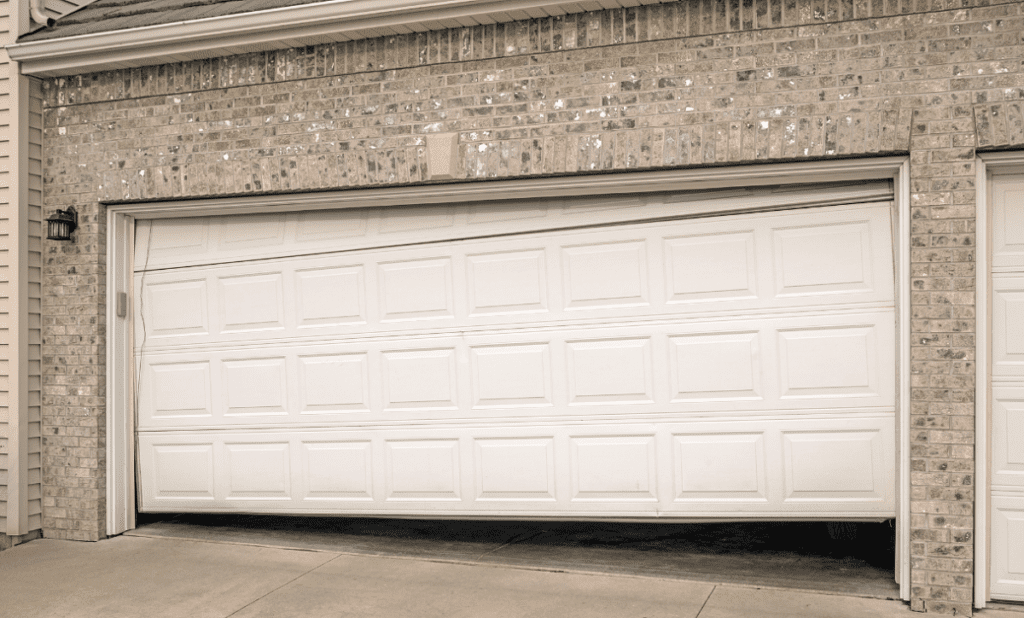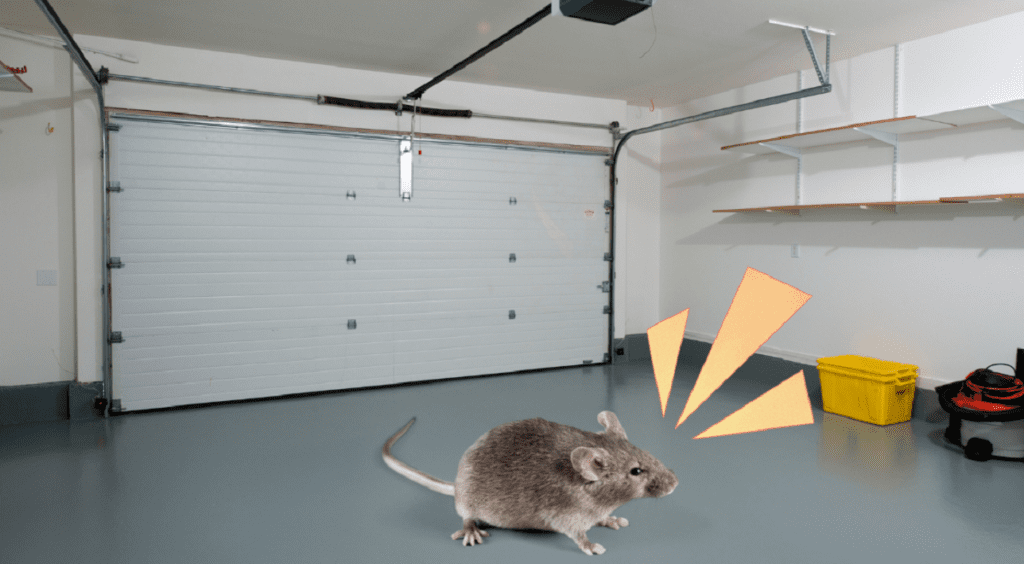
How Garage Door Sensors Work
Garage door sensors are a crucial safety feature of any modern garage door system. These sensors work by sending out an infrared light beam from one sensor to the other.
If an obstruction, such as a person or object, breaks the beam while the garage door is closing, the sensor will detect it and prevent the door from closing. It’s a pretty simple concept that can save lives and prevent damage to property.
But let’s be real for a moment. Garage door sensors can also be incredibly frustrating when they don’t work properly.
You’ve probably experienced that moment where you hit your garage door button, and nothing happens because one of the sensors is blocked or misaligned. It’s enough to make you want to rip your hair out!
And what about those times when you need to bypass the sensor altogether? Maybe you’re in a hurry, or maybe one of the sensors is malfunctioning and needs replacement.
Whatever your reason, knowing how to bypass garage door sensors can come in handy. Now, before we dive into how to bypass garage door sensors, let’s talk about some common issues that might cause them not to work properly in the first place.
Wiring issues are a common culprit when it comes to malfunctioning garage door sensors. Make sure all wires are securely connected and free from damage or wear and tear that could lead to them being cut or shorted out.
Sensor alignment is another issue that can cause problems with your garage door system. If one of your sensors is misaligned even slightly, it could trigger the safety mechanism and prevent your garage door from closing properly.
A laser pointer can come in handy here – simply use it to line up both sensors until they’re perfectly aligned with each other. Garage door sensors are an important safety feature, but they can also be downright infuriating at times.
Knowing how they work and what common issues might arise can help you troubleshoot any problems with ease. Stay tuned for our next section, where we’ll cover how to bypass garage door sensors when you need to.
Bypassing the Sensors
Garage door sensors are often a source of frustration and annoyance for homeowners.
They are designed to ensure safety by preventing the garage door from closing on anyone or anything that may be obstructing its path. However, they can also be triggered by innocent objects such as leaves or snow, causing the door to suddenly stop and reverse, leaving you stranded outside in the cold.
In this section, I will discuss how to bypass garage door sensors to avoid these inconveniences. Firstly, let’s talk about manual operation.
Most garage doors have a manual override option that allows you to open and close them without using the sensors. This can come in handy when there is an obstruction blocking the sensor’s beam or when they malfunction due to wiring issues.
To switch over to manual operation, locate the cord hanging from the center of your garage door opener and give it a firm tug downwards. This will release the spring tension on your automatic opener system, allowing you to operate it manually.
Another way of bypassing garage door sensors is by pressing and holding down the button on your opener until your garage door fully closes. This method tricks your system into thinking there isn’t an obstruction present since you’re actively holding down the button while it closes.
If neither of these methods works for you, then perhaps it’s time for a sensor alignment checkup or some wiring inspection. Over time alignment issues can crop up if something knocks one of your sensors out of position.
Most modern-day sensors use infrared light beams that need to be aimed at each other correctly; otherwise, they won’t function properly. Try using a laser pointer or some reflective surface like tape on your sensor housing unit while adjusting them so that they are perfectly aligned with one another.
Bypassing garage door sensors can be done in several different ways depending on what works best for you and what’s causing them not to function properly. You don’t always need a sensor replacement if they’re not working; sometimes, all it takes is a little bit of troubleshooting and tinkering to get them back up and running.
Press and Hold the Garage Door Button
One of the easiest ways to bypass garage door sensors is to press and hold the garage door button.
This method is simple, quick, and does not require any special tools. All you need is your finger and knowledge of where the button is located.
However, this method should only be used in emergency situations since it bypasses the safety features of the garage door sensors. Garage door sensors are designed to detect obstructions in their path by emitting an infrared light that detects a reflective surface on the opposite side.
When this beam is interrupted, the garage door will either stop or reverse its direction. By pressing and holding down the button, you are essentially telling your garage door to ignore these safety features in favor of manual operation.
While this method may seem like a quick fix for pressing issues, it’s important to note that there may be underlying problems with your sensors or wiring that could be causing them to malfunction in the first place. Therefore, if you have tried this method and continue to experience issues with your garage door sensors, it’s recommended that you seek further assistance from a professional technician.
While pressing and holding down your garage door button may seem like an easy way to bypass your sensors, it should only be used as a last resort during emergencies. It’s important to prioritize safety over convenience when dealing with potentially dangerous equipment such as garage doors.
Switch To Manual Operation
When all else fails, and your sensors are giving you a headache, it’s time to take matters into your own hands by switching to manual operation. This may seem like a daunting task, but trust me, it’s not rocket science.
All you need is a little patience and some basic knowledge of how your garage door works.
- To start off, locate the emergency release cord on your garage door opener. It’s usually red or yellow and hangs from the opener motor.
- Pull down on this cord to disconnect the opener from the door. This will allow you to open and close the door manually.
- It’s important to note that operating your garage door in manual mode means you have no safety net of sensors to prevent accidents. So use extra caution when opening or closing your garage door manually.
- Make sure there are no obstructions in the way, and keep an eye out for anything that may be in its path.
Switching over to manual operation is definitely not an ideal solution for bypassing garage door sensors, but it’s better than being locked out of your own home or risking any further damage. Just remember that safety should always be at the forefront of any manual operation with these doors, as they can cause severe injuries if not handled properly.
Check the Alignment
One of the most common reasons why garage door sensors malfunction is because of misalignment.
People tend to ignore the alignment aspect when it comes to installing garage door opener sensors, which can lead to a lot of trouble down the line. Here’s what you need to know about checking sensor alignment.
Firstly, make sure that there is no obstruction in the sensor’s way. If there is an object blocking any part of the infrared light emitted by the sensor, then it won’t work as intended.
It can be frustrating to realize that your garage door isn’t working as expected, only to find out that it was due to a bike or storage box blocking one of the sensors. So before you start thinking about bypassing anything, check for obstructions.
Next, you need a laser pointer or some tape to help you check if both sensors are aligned properly. Tape your laser pointer onto one sensor and make sure it shines straight and true onto its counterpart on the other side.
If they’re not lined up correctly, adjust their positions until both beams meet at exactly the same height on each sensor. Reflective surfaces can also cause some problems with alignment.
If your garage has shiny walls or floors, especially in direct sunlight, then those reflective surfaces could interfere with your sensors’ performance. Make sure your garage door sensors are placed away from any reflective surfaces and angles that might cause false readings.
Checking for sensor alignment might seem trivial, but it is an important aspect of maintaining a well-functioning garage door system. With just a few simple steps and tools like tape or a laser pointer, anyone can check their own garage door opener sensors for proper alignment and avoid any unnecessary headaches due to wiring issues or replacement needs later on down the line.
Check the Wiring
Another possible way of bypassing garage door sensors is by checking the wiring. Wiring issues are another common problem that can cause your garage door sensors to malfunction.
If the wiring is damaged or frayed, it can disrupt the communication between the sensors and prevent them from working properly. To check the wiring, it is best to start with a visual inspection.
Look for any obvious signs of damage, such as cuts, kinks, or breaks in the wires. If you notice any damage, it may be necessary to replace the wiring altogether.
If there does not appear to be any visible damage, try tracing the wires back to their source and checking for loose connections. Sometimes a simple loose connection is all that’s causing your garage door sensor problems.
Tighten any loose connections and check if this has resolved your issue. If all else fails with checking your wiring, you may need to consider getting a professional electrician to take a look at your system and diagnose any potential underlying issues that could be causing problems with your garage door sensors.
The cost of hiring an electrician may seem steep, but it will likely be less expensive than replacing an entire sensor unit or, even worse – having someone get injured due to a faulty garage door system. If you’re experiencing problems with your garage door sensors, it’s important not to panic or resort immediately to bypassing them entirely without first troubleshooting and trying different solutions, such as checking for wiring issues before making any drastic decisions about how to bypass garage door sensors.
Replace the Sensor
Replacing the garage door sensors may seem like a daunting task, but it’s actually quite simple and straightforward. Before purchasing a new sensor, make sure to check the model of your garage door opener to ensure compatibility. It’s also important to note that in some cases, replacing one sensor may require replacing both for optimal functionality.
Sensor replacement involves disconnecting the old sensors from the wiring and removing them from their brackets. Be sure to carefully label which wires connect to which sensor before disconnecting them to avoid any wiring issues during installation.
Next, attach the new sensors to their brackets and connect them using the labeled wires. It’s important to ensure that the new sensors are aligned properly before tightening them into place.
When aligning the new sensors, make sure they are facing each other and that there is no obstruction blocking their view of each other. Use a laser pointer or piece of tape on one sensor to help align it with the other sensor’s reflective surface.
Once properly aligned, tighten both sensors into place and test their functionality by opening and closing the garage door. If replacing the garage door sensors does not solve your issue with bypassing them, it may be worth considering consulting a professional for further troubleshooting.
In some cases, wiring issues or other underlying problems may prevent proper sensor alignment and functionality. Overall, while replacing garage door sensors may seem intimidating at first glance, it is actually a relatively simple process that can greatly improve your garage door’s safety and functionality in bypassing these pesky obstacles.
Frequently Asked Questions
How do I permanently bypass garage door sensors?
Bypassing garage door sensors permanently is generally not recommended as it can pose serious safety risks. However, for temporary troubleshooting, you could attach the two sensor wires directly to each other, but it’s vital to fix or replace malfunctioning sensors as soon as possible.
Can you turn off the garage door sensors?
Garage door sensors can be turned off, but this should only be done temporarily for troubleshooting purposes. It’s important to turn them back on as soon as possible to maintain the safety features of the garage door system.
Can a garage door be operated without sensors on?
A garage door can be manually operated without sensors on, but the automatic function will be compromised. The safety measures provided by these sensors are essential to prevent accidents and injuries. Hence they should be repaired or replaced if malfunctioning.
How do you trick a garage door sensor?
“Tricking” a garage door sensor generally refers to ensuring the sensor beam is unobstructed and aligned correctly; it’s not recommended to override safety mechanisms. If the sensors are malfunctioning, they should be repaired or replaced to maintain the safety standards of the garage door.
Can door sensors be bypassed?
Door sensors can be bypassed temporarily for troubleshooting purposes, but permanently bypassing them compromises the security and safety mechanisms of the door. Always consider fixing or replacing faulty sensors instead of bypassing them permanently.
Conclusion
Bypassing garage door sensors is not a difficult task and can be done with ease if one follows the correct steps. The first and foremost step is to understand how garage door sensors work and what their function is.
The sensors use infrared light to detect obstructions in the path of the garage door. If there is an obstruction, the sensor sends a signal to the motor telling it to stop moving.
If you are experiencing issues with sensor alignment, there are a number of steps you can take to fix it. You can check for any reflective surfaces that may be interfering with the sensor’s ability to detect obstructions.
You can also use a laser pointer or tape measure to ensure that the sensors are properly aligned. If wiring issues are causing problems with your garage door sensors, there are some easy fixes you can try before considering sensor replacement.
First, check all wiring connections for any loose or corroded wires. You may also opt for manual operation if your garage door opener has this feature.
If all else fails, it may be time for sensor replacement. However, before making that decision, you should always check with a professional technician as they will have experience in dealing with such issues.
Overall, bypassing garage door sensors requires careful diagnosis and troubleshooting of common problems such as alignment and wiring issues. While it may seem like an intimidating task at first glance, following these simple steps will help ensure that your garage door operates smoothly and safely without any hindrance or obstruction whatsoever!






